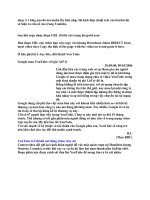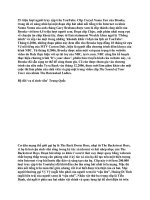WHY DID I CHOOSE YOU
Bạn đang xem bản rút gọn của tài liệu. Xem và tải ngay bản đầy đủ của tài liệu tại đây (95.28 KB, 8 trang )
buy.OLOGY
Designed by Trung Pham Tuan
- 94 -
for a moment as we head to the supermarket. Shouldn’t take long; there are
only a couple of items on our list.
Let’s make our way to the peanut butter section first. There’s Skippy, Peter
Pan, Jif. The generic supermarket offering, plus a few virtuous organic brands—
salt-free, no sugar added, the sort where the oil rises to the top.
Most consumers think about their choice for all of two seconds. In this case,
let’s say you grab the Jif, and we’re on to our next stop.
Was your decision rational? It may have seemed that way to you as you made
your choice, but it wasn’t, not by a long shot. If your decision-making process
was conscious—and articulated—my guess is it might have gone something like
this: I associate Skippy with childhood…it’s been around forever, so I feel it’s
trustworthy…but isn’t it laden with sugar and other preservatives I shouldn’t
be eating?…Same goes for Peter Pan, plus the name is so childish. And I’m not
buying that generic brand. It costs 30 cents less, which makes me suspicious. In
my experience, you get what you pay for…The organic stuff? Tasteless, the few
times I had it…always needs salt, too…Plus, didn’t I read somewhere that
“organic” doesn’t necessarily mean anything, plus it’s almost double the
price…Jif…what’s that old advertising slogan of theirs: “Choosy Mothers
Choose Jif”…Well, I am a fairly discriminating person…
These are the subconscious conversations that go on in our heads every time
we choose one product over another. Except they are rarely if ever uttered
aloud. Instead, we rely on almost instant shortcuts that our brains have created
to help us make buying decisions.
Our next stop is bottled water. There are dozens of glistening bottles, both
glass and plastic, and in all shapes and sizes, too. Again, let’s imagine the
rational conversation that might take place inside your head as you decide
which one to buy: Dasani…no, that’s the one Coke makes…Someone told me it
was nothing more than tap water with a phony name…I don’t want my bottled
water to be “commercial,” it should be special, chic…wait, what’s this one?
Iskilde. By far the most beautiful bottle on the shelf. From Denmark…No idea
what Iskilde means, but isn’t Denmark a land of snow and streams and healthy
people on ski slopes? Even the lettering on the bottle is clear-blue, like
Scandinavian eyes…The bottle is so clean and simple and icy-looking—like the
water from a Danish mountain stream…Iskilde: it’s almost like a Danish guy
saying “It’s Cold.” It’s expensive, too, which probably means it’s special…
buy.OLOGY
Designed by Trung Pham Tuan
- 95 -
And so Iskilde goes into your cart. You’ve never tasted the stuff, but your gut
tells you you’ve made the right decision. If I asked you to describe how you
came to your decision, you’d probably shrug and reply “Instinct,” or “No
reason,” or “I just did.” But the real rationale behind your choices was in fact
built on a lifetime of associations—some positive, others negative—that you
weren’t consciously aware of. Because when we make decisions about what to
buy, our brain summons and scans incredible amounts of memories, facts, and
emotions and squeezes them into a rapid response—a shortcut of sorts that
allows you to travel from A to Z in a couple of seconds, and that dictates what
you just put inside your shopping cart. A recent study conducted by German
brand and retail experts, Gruppe Nymphenberg, found that over 50 percent of
all purchasing decisions by shoppers are made spontaneously—and therefore
unconsciously—at the point of sale.
These brain shortcuts have another name: a somatic marker.
THE GREEK PHILOSOPHER
Socrates once told his student Theaetetus to imagine the mind as a block of wax
“on which we stamp what we perceive or conceive.” Whatever is impressed
upon the wax, Socrates said, we remember and know, provided the image
remains in the wax, but “whatever is obliterated or cannot be impressed, we
forget and do not know.”
1
A metaphor so suggestive and widespread that we
still say that an experience “made an impression.”
Imagine for a moment that you’re a six-year-old kid. You’re just home from
school and you’re hungry, so you wander into the kitchen to see what that nice
smell is that’s coming from the stove. Opening the oven door, you spy a navy-
blue Le Creuset pot. You begin to pull out the pot when you recoil backward,
your fingertips stinging. You’re in tears; your parents come running; and
assuming your fingertips weren’t too badly burned, a half hour later you’re
back playing with your trains, dinosaurs, or sharks.
The tenderness of your fingertips will vanish in a few days, but your mind
isn’t quite so lenient. It won’t forgive what happened; certainly it won’t ever
forget it. Subconsciously, the neurons in your brain have just assembled an
equation of sorts, one linking together the concepts of “oven” and “hot” and
“fingertips” and “grill” and “excruciating pain.” In sum, this chain-link of
buy.OLOGY
Designed by Trung Pham Tuan
- 96 -
concepts and body parts and sensations creates what scientist Antonio Damasio
calls a somatic marker—a kind of bookmark, or shortcut, in our brains. Sown
by past experiences of reward and punishment, these markers serve to connect
an experience or emotion with a specific, required reaction. By instantaneously
helping us narrow down the possibilities available in a situation, they shepherd
us toward a decision that we know will yield the best, least painful outcome.
Long after we’ve passed our sixth year, we “know” whether or not it’s right to
kiss a hostess we barely know good-bye after a cocktail party, whether it’s safe
to dive into a lake, how we should approach that German shepherd, or that if
we reach into an oven without a mitt on, our fingers will get burned. If
someone asks us how or why we know that, most of us shrug—what a funny
question—and chalk up our response to “instinct.”
These same cognitive shortcuts are what underlie most of our buying
decisions. Remember: it took you less than ten seconds to choose the Jif and the
Iskilde, based on a completely unconscious series of flags in your brain that led
you straight to an emotional reaction. All of a sudden, you “just knew” which
brand you wanted, but were completely unaware of the factors—the shape of
the product’s container, childhood memories, its price, and a lot of other
considerations—that led to your decision.
But somatic markers aren’t simply a collection of reflexes from childhood or
adolescence. Every day, we manufacture new ones, adding them to the bulging
collection already in place. And the bigger our brain’s collection of somatic
markers, whether for shampoos, face creams, chewing gums, breath mints,
potato chips, vodka bottles, shaving creams, deodorants, vitamins, shirts, pants,
dresses, TVs, or video cameras, the more buying decisions we’re able to make.
In fact, without somatic markers we wouldn’t be able to make any decisions at
all—much less parallel park a car, ride a bike, flag a taxi, decide how much
money to take out of the ATM machine, plug a lamp into an electrical socket
without getting electrocuted, or take a burning casserole dish out of the oven.
For example, why do many consumers choose to buy an Audi over other cars
with equally attractive designs, comparable safety ratings, and similar prices? It
might very well have something to do with the company’s slogan, Vorsprung
durch Technik. Now, I strongly doubt many people outside of Germany or
Switzerland know what this means (roughly, it translates to “progress and/or
head start through technology” U2 fans, of which I’m one, will note that Bono
murmurs the phrase at the beginning of the song “Zooropa”). But that’s not the
point. Most people will guess correctly that the phrase is German. Our brains
buy.OLOGY
Designed by Trung Pham Tuan
- 97 -
link together “automobile” with “Germany” with everything we’ve picked up
over our lifetimes about top-of-the-line Teutonic car manufacturing. High
standards. Precision. Consistency. Rigor. Efficiency. Trustworthiness. The
result: we walk out of the showroom holding the keys to a new Audi. Why?
We are rarely conscious of it, but the fact is that in a world teeming with cars
that are for the most part indistinguishable, a somatic marker that connects
Germany with technological excellence comes alive in our brain and ushers us
toward a brand preference.
Or let’s imagine that you’re shopping for a digital camera. Even with the vast
array of features—optical zoom, tony image processors, face detection gizmos,
red-eye correctors—most of them look exactly the same. So why do you find
yourself gravitating toward the ones that come from Japan? Once, back before
Japan became a global leader in manufacturing technology, the words “Made in
Japan” turned you off. You associated it with cheap kids’ toys, gadgets that fell
apart after fifteen minutes, and crummy, mass-marketed merchandise put
together by people working in substandard conditions. But now anything
Japanese seems to you a marvel of cutting-edge sophistication. Again, based
purely on a series of unconscious markers, your mind has linked together Japan
with technological excellence and you leave the store with a new Japanese
camera under your arm.
This is all very well and good, but by now you might be wondering, how do
these markers form? And do companies and advertisers work to deliberately
create these in our brains? You bet. Take TV commercials. If you’ve ever
shopped for tires, you know that they all look the same—Dunlop, Bridge-stone,
Goodyear—nothing but a mind-numbing ocean of black rubber. Yet you
automatically make your way, say, to the store’s Michelin section. You know
you’re making the right choice but you can’t really articulate why. In truth,
your brand preference has very little to do with the tires themselves, but
instead with the somatic markers the brand has carefully created. Remember
the cute baby Michelin once used in their advertising? Or what about the
Michelin man, whose plump, round appearance suggests the protective padding
of a well-made tire? And then there are the Michelin Guides, those slender,
authoritative, high-end travel and food guides (which the company invented so
that consumers would drive around in pursuit of the best restaurants—and thus
purchase more tires). Point is, all these seemingly unrelated bookmarks
deliberately forge certain associations—safety for your child passengers; sturdy,
reliable durability; and a high-quality, top-of-the-line, European experience.
buy.OLOGY
Designed by Trung Pham Tuan
- 98 -
And it’s these powerful associations that come together to shepherd you toward
a choice that feels rational, but that isn’t at all.
Professor Robert Heath, a British consultant who among other things has
written extensively about somatic markers, has examined the success of a brand
of British toilet paper known as Andrex that outsells its nearest rival, Kleenex,
in the United Kingdom by an almost two-to-one margin. Both companies spend
the same amount of money on TV ads, both are of equally high quality, and
both cost approximately the same. Heath’s explanation for Andrex’s success? A
small Labrador puppy. But what, pray tell, does a little dog have to do with an
eight-pack of toilet paper?
For years, Andrex has used its puppy mascot to advertise how “soft, strong,
and very long” its toilet paper is. In a series of commercials, the puppy is seen
skidding down a snowy hill on a sheet of toilet paper; in another, a woman
holds the puppy while behind them a long lacy banner of Andrex toilet paper
billows and flutters behind a speeding car. At first, the connection between
puppies and toilet paper seems obscure, kind of random. But as Heath writes,
“Puppies are linked with growing young families; puppies are even linked to
toilet training. The connections between any of these concepts and the puppy
associations can be created and reinforced every time the ads are seen.” Heath
adds, “When faced with the need to buy toilet paper, the average consumer will
not stop and try to recall the ads to mind. However, when they tap into their
intuitive feelings about the two brands, the likelihood is that they will come up
with a far richer set of conceptual links for Andrex than for Kleenex…All they
might do is ‘feel’ that Andrex is somehow indefinably ‘better’ than Kleenex.”
2
For advertisers, it’s easy and inexpensive to create a somatic marker in
consumers’ brains. Let’s take an example from real life. How do you know to
look both ways when you cross the street? Chances are you once had a close
call that came as a shock—and that shock has stuck with you ever since. Since
somatic markers are typically associations between two incompatible
elements—in this case, an uneventful morning and a sudden screech of
brakes—they are far more memorable, and lasting, than other associations we
form throughout our lives. Which is why, in attempting to hook our attention,
advertisers aim to create surprising, even shocking associations between two
wildly disparate things.
Take a guy by the name of Tom Dickson. Tom Dickson resembles any
midwestern, middle-aged suburban dad. But this suburban dad has a rather out-









